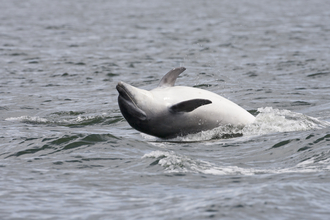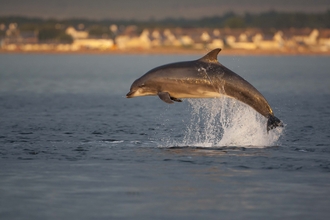White-beaked dolphin ©John Carnell
White-beaked dolphin
Look out for the distinctive white beak that gives this energetic dolphin its name. Don’t be surprised to see them breach and bowride too!
Scientific name
Lagenorhynchus albirostrisWhen to see
January to DecemberSpecies information
Category
Statistics
Length: up to 3.2m longWeight: up to 350kg
Lifespan: unknown
Conservation status
Considered to be of Least Concern on the IUCN Red List of species, they are protected in the EU under Annex IV of the EU Habitats Directive and listed under Annex II of CITES. In the UK they are protected under the Wildlife and Countryside Act 1981 and the Conservation of Habitats and Species Regulations 2010.
They are a Priority Species under the UK Post-2010 Biodiversity Framework.
They are a Priority Species under the UK Post-2010 Biodiversity Framework.
Habitats
About
A social species of dolphin, usually found in pods of 5-10 individuals in UK seas; though much larger groups can be seen elsewhere in their range. Like most species of dolphin, they are incredibly acrobatic and will often approach boats to bowride. White-beaked dolphins are a subpolar species, common in the cooler waters of the North Atlantic. A small population is found year-round in Lyme Bay, Devon/Dorset and dolphins are spotted close to shore in Northumberland in the summer months. White-beaked Dolphins feed on fish and work together to herd large schools.How to identify
A large, stocky dolphin with a distinctive white beak. They are black in colour, with a lighter underbelly. A white flash on its sides and back help differentiate from other dolphins. They have a tall curved dorsal fin.Distribution
The cold temperate waters of the continental shelf and open waters of the North Atlantic Ocean. Nationally, populations of white-beaked dolphins can regularly be found in Lyme Bay, around the Hebrides and seasonally off the North East England coast.Did you know?
White-beaked Dolphins are often sighted with young calves during the summer months in both Lyme Bay and off Northumberland, suggesting these may be important nursery areas.How people can help
Report your White-beaked Dolphin sightings to your local Wildlife Trust. If you spot White-Beaked Dolphins whilst at sea, maintain a distance of at least 100m, especially if a calf is present. If the dolphins approach you, maintain a constant speed and allow them to interact on their own terms and leave at will. If you find a stranded White-beaked Dolphin (dead or alive), please report it to the relevant authority. The Wildlife Trusts are calling for a Marine Conservation Zone (MCZ) to protect the White-beaked Dolphin population in Lyme Bay. To support our campaign, become a Friend of MCZs today.





